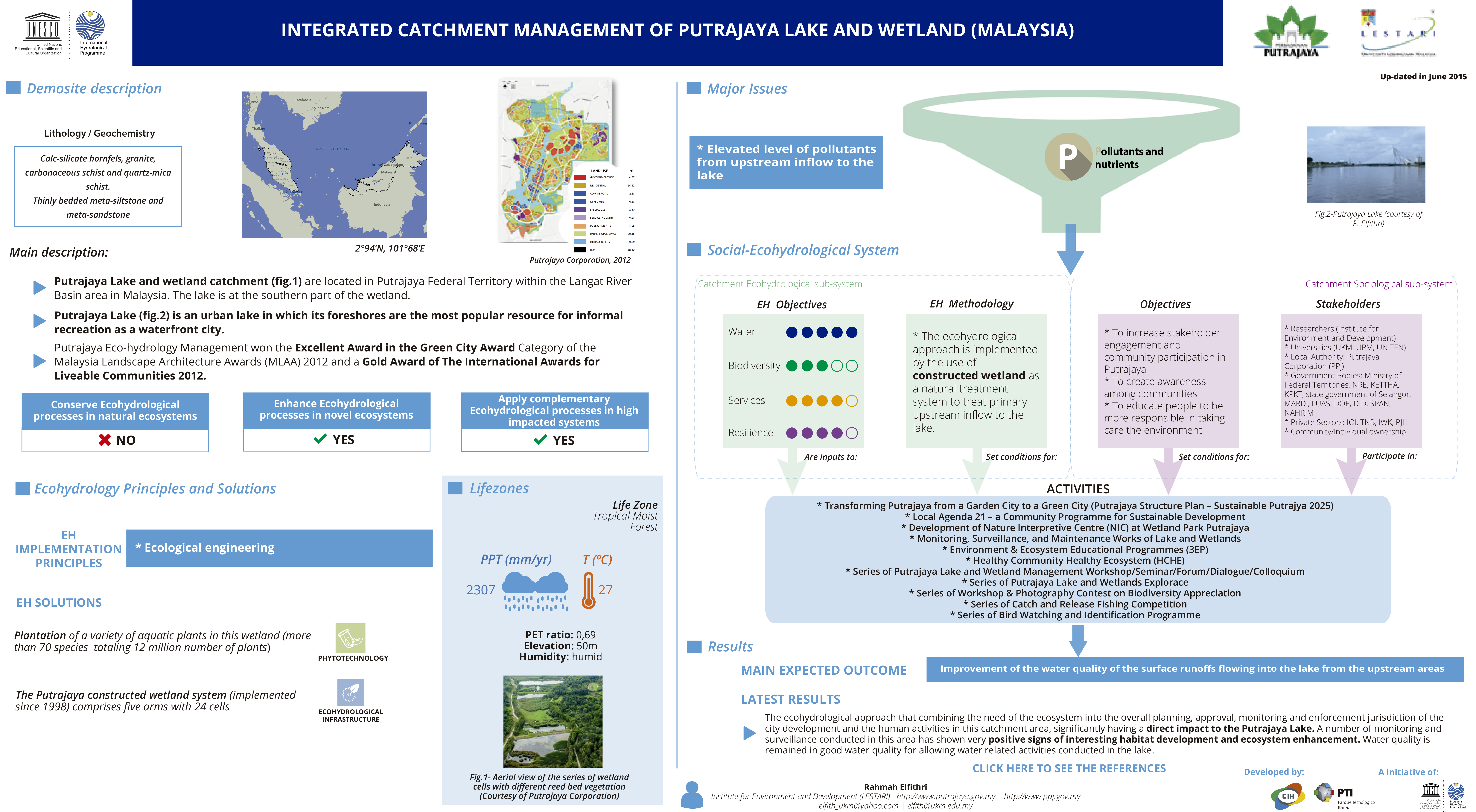INTEGRATED CATCHMENT MANAGEMENT OF PUTRAJAYA LAKE AND WETLAND (MALAYSIA)


Description
Location


Sketch

Information about lithology/geochemistry:
The Quartenary river alluvium named the Simpang Formation is the youngest deposit that overlies the older Carboniferus-Permian Kenny Hill Formation, and Silurian Hawthornden Schist is the oldest rock formation found in this area. Rock cores from Putrajaya consist of various materials including calc-silicate hornfels, granite, carbonaceous schist and quartz-mica schist. Their lithology comprises of thinly bedded meta-siltstone and meta-sandstone
Main Description
- Putrajaya Lake and wetland catchment (fig.1) are located in Putrajaya Federal Territory within the Langat River Basin area in Malaysia. The lake is at the southern part of the wetland.
- Putrajaya Lake (fig.2) is an urban lake in which its foreshores are the most popular resource for informal recreation as a waterfront city.
- Putrajaya Eco-hydrology Management won the Excellent Award in the Green City Award Category of the Malaysia Landscape Architecture Awards (MLAA) 2012 and a Gold Award of The International Awards for Liveable Communities 2012.
Enhance ecohydrological processes in novel ecosystem
YES
Apply complementary Ecohydrological processes in high impacted system
YES
This table presents the different categories of ecosystem services that ecosystem can provide, divided in:
Provisioning Services are ecosystem services that describe the material or energy outputs from ecosystems. They include food, water and other resources.

Food: Ecosystems provide the conditions for growing food. Food comes principally from managed agro-ecosystems but marine and freshwater systems or forests also provide food for human consumption. Wild foods from forests are often underestimated.

Fresh water: Ecosystems play a vital role in the global hydrological cycle, as they regulate the flow and purification of water. Vegetation and forests influence the quantity of water available locally.
Regulating Services are the services that ecosystems provide by acting as regulators eg. regulating the quality of air and soil or by providing flood and disease control.

Local climate and air quality: Trees provide shade whilst forests influence rainfall and water availability both locally and regionally. Trees or other plants also play an important role in regulating air quality by removing pollutants from the atmosphere.

Carbon sequestration and storage: Ecosystems regulate the global climate by storing and sequestering greenhouse gases. As trees and plants grow, they remove carbon dioxide from the atmosphere and effectively lock it away in their tissues. In this way forest ecosystems are carbon stores. Biodiversity also plays an important role by improving the capacity of ecosystems to adapt to the effects of climate change.

Moderation of extreme events: Extreme weather events or natural hazards include floods, storms, tsunamis, avalanches and landslides. Ecosystems and living organisms create buffers against natural disasters, thereby preventing possible damage. For example, wetlands can soak up flood water whilst trees can stabilize slopes. Coral reefs and mangroves help protect coastlines from storm damage.

Waste-water treatment: Ecosystems such as wetlands filter both human and animal waste and act as a natural buffer to the surrounding environment. Through the biological activity of microorganisms in the soil, most waste is broken down. Thereby pathogens (disease causing microbes) are eliminated, and the level of nutrients and pollution is reduced.

Erosion prevention and maintenance of soil fertility: Soil erosion is a key factor in the process of land degradation and desertification. Vegetation cover provides a vital regulating service by preventing soil erosion. Soil fertility is essential for plant growth and agriculture and well functioning ecosystems supply the soil with nutrients required to support plant growth.

Biological control: Ecosystems are important for regulating pests and vector borne diseases that attack plants, animals and people. Ecosystems regulate pests and diseases through the activities of predators and parasites. Birds, bats, flies, wasps, frogs and fungi all act as natural controls.
Ecosystem services "that are necessary for the production of all other ecosystem services". These include services such as nutrient recycling, primary production and soil formation.

Habitats for species: Habitats provide everything that an individual plant or animal needs to survive: food; water; and shelter. Each ecosystem provides different habitats that can be essential for a species’ lifecycle. Migratory species including birds, fish, mammals and insects all depend upon different ecosystems during their movements.
Cultural Services corresponds nonmaterial benefits people obtain from ecosystems through spiritual enrichment, cognitive development, reflection, recreation, and aesthetic experiences.

Recreation and mental and physical health: Walking and playing sports in green space is not only a good form of physical exercise but also lets people relax. The role that green space plays in maintaining mental and physical health is increasingly being recognized, despite difficulties of measurement.

Tourism: Ecosystems and biodiversity play an important role for many kinds of tourism which in turn provides considerable economic benefits and is a vital source of income for many countries. In 2008 global earnings from tourism summed up to US$ 944 billion. Cultural and eco-tourism can also educate people about the importance of biological diversity.

Aesthetic appreciation and inspiration for culture, art and design: Language, knowledge and the natural environment have been intimately related throughout human history. Biodiversity, ecosystems and natural landscapes have been the source of inspiration for much of our art, culture and increasingly for science.

Spiritual experience and sense of place: In many parts of the world natural features such as specific forests, caves or mountains are considered sacred or have a religious meaning. Nature is a common element of all major religions and traditional knowledge, and associated custos are important for creating a sense of belonging.
Lifezones

![]()
PPT(mm/yr): 2307.0
![]()
T(ºc): 27.0
| Elevation of demosite: | 50.0 meters above sea level |
| Humidity: | Humid |
| PETr (by year): | 0.69 |
EH Principles
Ecological engineering (integration, dual regulation and biotechnologies in catchment scale for enhancement of ecological potential)
ECOHYDROLOGY ENGINEERING SOLUTIONS
The Putrajaya constructed wetland system (implemented since 1998) comprises five arms with 24 cells
 Ecohydrological Infrastructure
Ecohydrological Infrastructure
Plantation of a variety of aquatic plants in this wetland (more than 70 species totaling 12 million number of plants)
 Phytotechnology
Phytotechnology
Major Issues
- Elevated level of pollutants from upstream inflow to the lake



Expected Outcomes
Improvement of the water quality of the surface runoffs flowing into the lake from the upstream areas
Latest Results
- The ecohydrological approach that combining the need of the ecosystem into the overall planning, approval, monitoring and enforcement jurisdiction of the city development and the human activities in this catchment area, significantly having a direct impact to the Putrajaya Lake. A number of monitoring and surveillance conducted in this area has shown very positive signs of interesting habitat development remain in good water quality for allowing water related activities conducted in the lake.
Contacts
Rahmah Elfithri
- elfith_ukm@yahoo.com
- http://www.putrajaya.gov.my
- Institute for Environment and Development (LESTARI)
- http://www.putrajaya.gov.my

Social ecohydrological system
EH Objectives
EH Methodology
Catchment Ecohydrological sub-system
Objectives
Stakeholders
Catchment Sociological sub-system
Activities